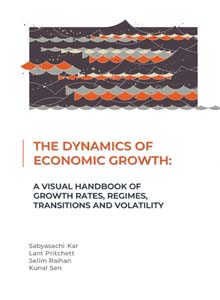
The Dynamics of Economic Growth: A Visual Handbook of Growth Rates, Regimes, Transitions and Volatility
 Citation: Kar, S. L. Pritchet, S. Raihan and K. Sen (2013),The Dynamics of Economic Growth: A Visual Handbook of Growth Rates, Regimes, Transitions and Volatility, University of Manchester, UK
Citation: Kar, S. L. Pritchet, S. Raihan and K. Sen (2013),The Dynamics of Economic Growth: A Visual Handbook of Growth Rates, Regimes, Transitions and Volatility, University of Manchester, UK
Abstract: Why there are such significant and persistent differences in living standards across countries is one of the most important and challenging areas of development policy. In spite of a voluminous literature on the causes of economic growth, we still have a long way to go in understanding why the growth experiences of countries differ so much, why growth changes so much (for good and ill) over time, and why only a handful of developing countries have seen their incomes converge to the levels observed in developed countries. To understand the causes of economic growth, we first need to understand what growth is. Much of the focus in the academic and policy literature on “growth” has been on steady-state or long-run average rates of growth of output per capita, or equivalently, comparing levels of income. But the focus on one single growth rate for a particular country misses the point that most countries observe dramatic changes in their growth of per capita income. We present visually the dynamics of the growth experiences of 125 countries. The graphs themselves (and embedded numeric information) highlight the key point that we would like to convey in this Handbook – that economic growth is dynamic and episodic and that many countries have gone through very different growth phases. We identify the timing and magnitude of “breaks” or “episodes” or “regime transitions” for all our 125 countries from the application of a standard statistical procedure. Viewing economic growth as transitions across growth phases would imply that we would need to move beyond current approaches to growth, and that new “third generation” theoretical models and empirical methods would need to be developed to understand what determines economic growth.



